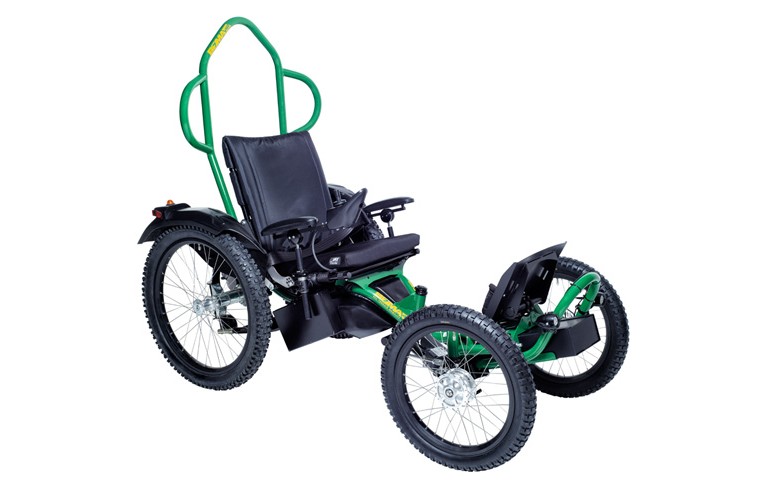Remember the days when people involved in disability used to talk about places that were inaccessible? Although that conversation isn’t completely redundant there are definitely more solutions around that show that getting out and about, irrespective of the terrain is just about getting hold of the correct equipment.
We look at a few of the growing number of ‘all-terrain’ wheelchairs.
What might strike you immediately is that the following examples don’t really follow the classic (or standard) wheelchair shape or spec – then again, they don’t get tripped up by the bog-standard challenges that everyday wheelchairs face.
Mountain Trike
It’s a bold statement to make, but if the wheelchair were to be ‘re-invented’ it might be a little more like the Mountain Trike. Pushing forwards on wet or muddy rims and using the brakes to steer just don’t seem like effective ideas next to the lever drive system employed by the three-wheeled wonder.
To be fair, the standard wheelchair set-up works satisfactorily in the everyday environment. Where you’ll really notice the capability of the Mountain Trike of course, is when you take it into areas that are literally inaccessible to other wheelchairs. The ratchet system not only allows users to ‘row’ towards a head of steam but it can also transfer the necessary torque needed to carefully clamber over barriers and take on gradients.
The pivot steering lever acts as a joystick controlling the rear turning wheel, meaning that unlike on standard wheelchairs there is no need to use the brakes and run down any momentum gained. (It also makes for smoother steering as well.) Hydraulic brakes and air suspension keep the wheelchair balanced, comfortable and safe along the way and yet it folds up neatly for stowing back in the car etc.
The efficient push system and manoeuvrability that comes through the trike design is excellent and really does enable the user to not only go places – but to enjoy them at the same time.
Boma7 All Terrain
This is on the outside edge of what can be called a ‘powered wheelchair’, given that it’s much bigger and shaped more like a small car. What can’t be denied is that for disabled people that prefer off-roading to sticking to the paths, it fits the bill entirely.
The Boma 7 is built on a steel tube frame chassis and fitted with either handlebar or joystick control (for people with limited arm or hand function). Other additional specifications can be built to suit such as the positioning of the joystick or specialist seating etc.
Although the Boma 7 is available in one standard size (seat base 42x42cm) the seating, controls and footplate are fully adjustable, allowing the chair to be enjoyed by users of different ages and heights. (Maximum user weight 110kg.)
Despite its size, the Boma 7 is a mobility device that is legally allowed on footpaths and bridleways. This is why it is set with a maximum speed of 8mph, which is actually much swifter than you might think, especially over rough terrain.
If you wanted to use The Boma 7 in a more domestic outdoor setting it can be fitted with a road lighting kit, when it will become a Class 3 Mobility Device and covered by the appropriate regulation. (Registration with the DVLA is free and you should also obtain at least third party insurance cover.)
Boma 7 has a typical range on (trail surfaces) of around 12-16 miles but this can be dependent on loading and other variables.
Mybility Four X DL All Terrain Wheelchair
All-terrain wheelchairs come in a variety of shapes and sizes. The Mybility Four X DL model All Terrain Wheelchair is arguably the only wheelchair on this list that can truly claim to be useful on ‘all’ terrain. Clearly, some of the larger models are going to struggle in domestic outdoor settings such as on narrow streets – and the home environment is likely to be entirely off-limits.
The MyBility Four X DL certainly has the chops for a variety of outdoor scenarios but is small and manoeuvrable enough to take into your home. Because of design aspects, such as smaller wheels it won’t wreck your doorframes or carpets and would make a decent ‘everyday’ wheelchair.
The Mybility All Terrain Wheelchair offers a great mix of capabilities that make it a genuine ‘all-rounder’. Gradients, either uphill or downhill aren’t a problem and you’ll have no difficulty in comfortably and safely covering mud, grass, cobbles, rocky areas, steep slopes, steps, high kerbs, sand or even snow. The secret of its success is that the Four X model has four wheel drive and four wheel steer with powerful motors and an electric tilt in space gravity adjustment system and a unique suspension system.
The Four X comes with a range of adjustable fixtures including armrests and footrests as well as LED lights, indicators and safety mirrors, variable speed settings and a choice of seating sizes and styles. It also includes a convenient seat riser to enable users to reach up to a higher level than they’d usually be able to from an ordinary wheelchair.
The Four X can also be fully adapted to meet individual disability needs including a unique chin tracking head control designed by Mybility.
Because it can be fully tailored and adapted it is suitable for everyone from children aged six years to elderly adults.
Trekinetic K-2
Wheelchair users and manufacturers alike have been grappling with how to gain greater freedom and flexibility whilst working within the parameters of what a wheelchair is – and must be. This has definitely stirred development over the decades and produced a host of different designs, functionality and even materials.
The K2 for example, does not use a traditional metal chassis but instead has a light weight carbon fibre monocoque seat. If you aren’t familiar with aeronautic or high end motor vehicle technology, the term ‘monocoque’ essentially means ‘one piece’ and in this case specifically that the chassis is integral to the body of the wheelchair, rather than just another part of it. This offers comfort and support, because it is anatomically formed to suit the human shape rather than being simply two pieces of cushion slotted together.
You might also note that the pushing wheels are placed at the front (rather than in their traditional rear position). This takes advantage of the fact that wheel propulsion is easier when the user pushes horizontally with back supported. (Trekinetic say that “It’s the same principle used by body builders, who find they can lift more weight, lying on their back”.)
Of course the other benefit of having the wheels at the front, is that they simply roll over obstacles more easily – whilst retaining a smooth ride in domestic outdoor settings, with some of that stability gained because, as three-wheeler, all of the wheels are always touching the ground, regardless of the terrain.
The K2 is equipped with automatic tilt-in-space seat, and nitrogen filled shock absorber which comes into its own when traversing up or down hills or climbing kerbs. A variable wheel camber system means that users can have the wheels slanted for off road stability, but switch to vertical so they can get through doorways etc. (These changes can be actioned without tools)
Whilst the monocoque chassis might seem like something of a gimmick, it has a positive benefit on weight, strength and comfort. (Expect to see more carbon fibre wheelchairs in the future.)
The Sandcruiser All Terrain Wheelchair
Although this is technically an all-terrain wheelchair, it’s clear that it is something of a specialist set of wheels. Essentially, the Sandcruiser is a beach model although it will travel across other soft or mushy surfaces with similar ease such as gravel, mud and snow. Perhaps it isn’t unfair to caution against over-confidence outside of the beach environment since one sharp object getting in contact with those soft balloon tyres could end the trip at a stroke and besides, again, the wheelchair is too big and bulgy to go wherever else you might want to go.
The Sandcruiser is an attendant wheelchair and will also take effort on the part of the carer to push it because of the inherent traction caused by so much wheel surface area being in contact with the ground. (That’s why it doesn’t sink.)
It is, however, very comfortable for the user and a great piece of kit in the correct environment. (There can’t be many wheelchairs able to perform a 360° turn on sand.) It is designed with travel in mind and will dismantle and assemble easily and features breathable acrylic fabric which dries quickly and is resistant to salt water. (Maximum user weight is 120kg.)
www.allterrainwheelchairs.co.uk
Overlander 4
The Overlander is another powered wheelchair with specific capability in getting off the beaten track. Utilising a unique, patented independent suspension system means that users are not jostled whilst undertaking their expedition, be it over debris, muddy fields, rocks, sand or streams or on steep gradients.
Seating and steering are adjustable to suit personal needs. Steering is controlled through handle bars or joystick. The handle bars can be specifically positioned and configured to allow for control differences for left and right hand (depending again on the needs of the user). The joystick can also be positioned to suit and the 4×4 and front wheel drive setups enable an incredibly tight turning circle.
The Overlander 4 is equipped with a side roll bar for protection – and an aluminium overhead roll bar can be ordered to give full protection if required. (The roll bar lifts up on either the left or right hand side for easy access with an option available to have both sides lift – or removed entirely if not needed.)
There are two standard speed options; the first, 4mph, is geared towards heavy duty off-roading or for lighter expeditions, 8mph (geared for less demanding surfaces).
Users can opt for the motors to be water-proofed, so that they can be hosed down after use.
